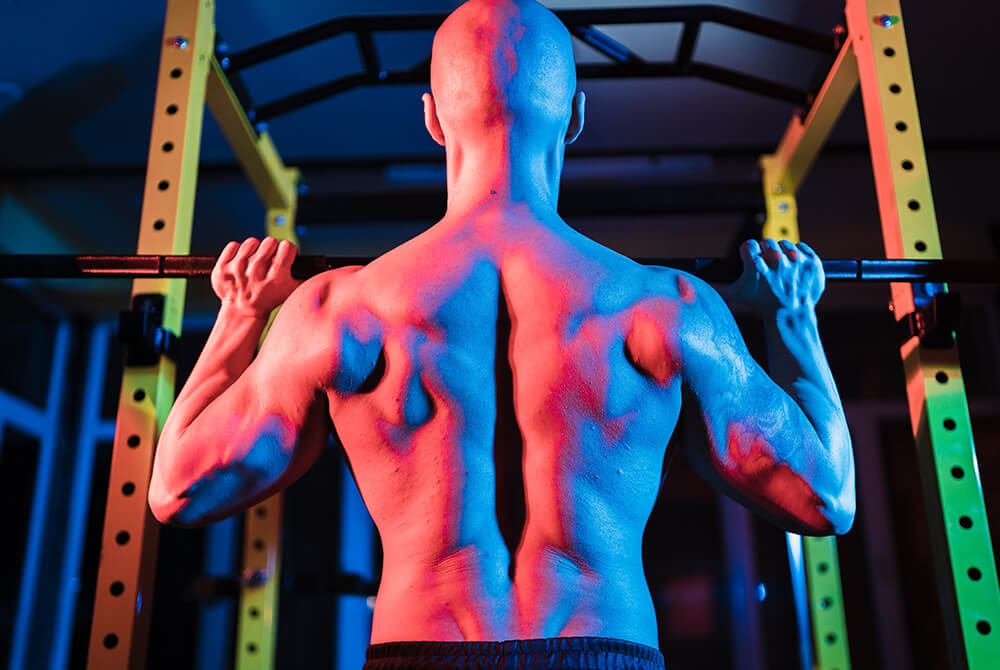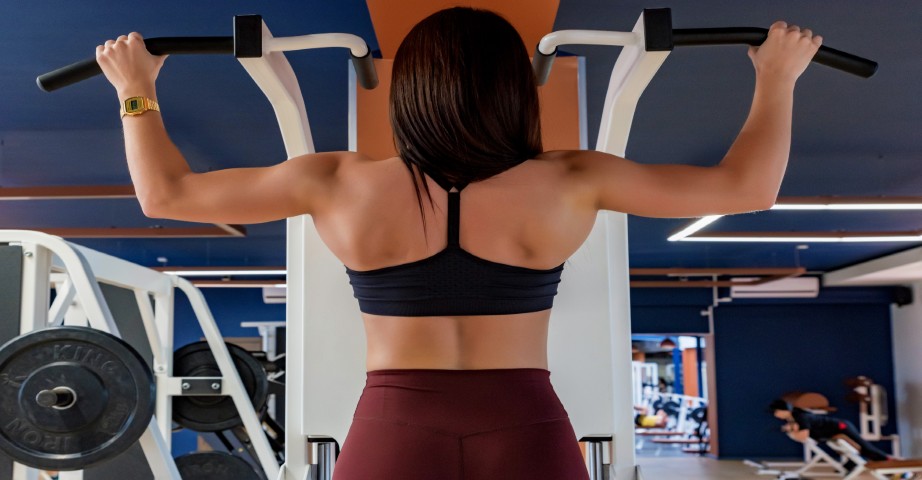The best exercises for your back. How to do a back workout?

Back exercises not only enable you to build and sculpt strong back muscles. They also help to keep your posture in good condition and prevent pain resulting from daily activities and muscle weakness. As the back is made up of large groups of muscles, its training must be varied - consisting of numerous exercises and movements from different angles. Which back exercises are worth doing? What should you bear in mind during your back workout?
Back exercises - why should you do them?
The muscles of the back are involved in most of our daily activities, as well as in many strength exercises in which they take part 'by the way'. A broad, muscular back in the shape of an inverted triangle is the training goal of many men who work out at the gym. Simultaneously, back exercises are often skipped in training by beginners and women. However, women should not be afraid to engage in back exercises. Their hormonal economy prevents unnatural muscle growth and masculinisation of the body shape. On the other hand, balance and proportional development of both the chest and back muscles is essential in training.
It is important to remember that muscles are not only there to look attractive, but mainly to fulfil their biological functions. Why should you not forget about your back during a workout?
Strength and shape of back muscles
People who train at the gym choose back exercises for strengthening, enlarging and sculpting them. A strong back makes it easier to perform exercises in the correct technical manner. They also help athletes perform better using other muscle areas, as they give them support during workouts. They also help athletes perform better using other muscle areas, as they give them support during workouts.
A strong back means good posture
The back muscles, together with the stomach ones , form the core of the silhouette that maintains the correct posture and protects the spine as well as the internal organs. he stronger the back muscles, the easier it is to have a straight posture during work and everyday activities.. Strong muscles in the back mean less rounding of the back, shoulders dropping inwards and closing the chest. Weakened ones, on the other hand, tend to shrink and tighten.. For sure, you are familiar with the feeling of stiff, hard muscles. Therefore, back exercises help to prevent the occurrence of back, shoulder or neck pain resulting from poor posture and muscle weakness.
Back workout is an energy expenditure
The back is a large muscle area. Its training requires a solid effort and loads. People who also train for a calorie deficit and to accelerate fat burning can enjoy these benefits from the back workout. After strength training, there is an EPOC effect - increased post-workout oxygen consumption. It means that even after the workout is over, the muscles continue to burn more calories even though they are already resting. Due to the large surface area of the back and the weight used, back exercises help to generate a significant calorie deficit..
Recommended products
Back workout - principles of back exercises
Back workout is based on the movements of pulling the weight towards you or pulling your body weight to the bar. Significantly, it is essential to control that the pulling force does not come mainly from the shoulders, but from the back. Nowadays, more and more personal trainers are saying that the distinction between exercises for the width and thickness of the back muscles is just a myth. It does not change the fact that effective back training requires movements from multiple angles,because of the large size of the back muscles, especially the wider ones.
Back training is carried out:
- vertically, usually by pulling up on a bar or pulling down a vertical lift bar,
- horizontally, by doing various types of rowing.
As a very large muscle group, the back requires different exercises to be performed during a single session. Training should be as diverse as possible, using variants of different exercises, to ensure that the white (strength) fibres are highly stimulated for muscle development and avoid stagnation.
The weight and number of repetitions should be matched to your current abilities. However, it is better to do more repetitions, so professionals advise performing 8-12 in a series. It is due to the structure of the widest back muscle, which is dominated by endurance muscle fibres.
For correct back training technique, it is very important to work with your shoulder blades, which should be pulled towards each other and slightly downwards during exercise.. This movement helps to open up the chest, maintain correct posture and increase the effectiveness of the exercises.
The best exercises for your back at the gym
There are several basic back exercises, but each of them can be easily transformed into different variations by changing the type or width of the grip (underhand, overhand, neutral grip), using benches, balls or exercising without them. It is much easier to do back exercises in a gym than at home, as they often require specific equipment and loads.
Pull-ups on a bar
The pull-up is the king of back exercises. It is considered by experts to be the most effective exercise, but also the most difficult. It is not recommended for beginners as it requires a lot of strength. However, pull-ups can and should be learned if you dream about a V-shaped back.. You don't need a gym to do pull-ups. Anyone can fit a bar in a door frame and start doing the best possible back exercise.
How to perform the exercise?
Place your hands wider than your shoulders and grab the bar with an overhand, closed grip. Elbows move along the torso. Chest pushed forward. Pull your body up to the bar on an exhale until your chin reaches the bar. On an inhale, lower your body by straightening your forearms. While pulling up, the legs should hang loosely or be crossed.
Performing this best back exercise, you can modify the width and type of grip. However, remember to keep your grip closed at all times when pulling up on the bar, minimising the risk of falling. Don't swing on the bar. It is easier to pull yourself up this way, but the effects are lower. Make slow moves and do not lower your body rapidly.

Seated vertical lift bar pulls
The vertical pull-up lift is the primary choice among people doing back workout at the gym. The vertical lift bar pull-down is not as effective as the pull-up on a bar, but it is definitely one of the best and most commonly performed back exercises. A big advantage of the lift is that the load can be easily adjusted to your needs. Seated horizontal lift-back exercises are also popular at the gym.
How to perform the exercise?
Sit facing the lift, locking your knees under the rollers. Straighten your arms upwards, and grab the bar with a shoulder-width grip. Lean back slightly, lower your shoulders, pull your shoulder blades together and, on an inhale, pull the bar until your elbows are at hip height. The bar should be at the top of your chest. Hold the weight for a moment and on an exhale, calmly, without sudden movements, lower the weight, straightening the arms and avoiding over-extension of the elbow joints.
Trunk lift on a Roman bench
The trunk lift is an exercise that engages fewer back muscles than pull-ups on a bar or pull-up bar work, but it is an interesting variation for more popular exercises. Implementing the trunk lift into your back training is one way of varying your training plan and providing your back muscles with new impulses, which is very important for their growth. The trunk lift on a rowing bench is an exercise typically performed in the gym. Its home versions are the trunk lift while lying on a mat or supported by a gym ball.
How to perform the exercise?
Place yourself stably on a Roman bench so that the end of the bench support is in line with your hips. Bring your chin to your chest and cross your arms over your torso. On the inhale, lower your torso slowly below your hip line. On the exhale, perform a dynamic movement of lifting your torso up. At the end of the lift, pull your shoulder blades down, towards you to reinforce the effect of the exercise.
More advanced individuals can add weight with dumbbells held in the hands and pulled to the chest.
Bar rowing
Bar rowing is one of the best exercises to engage most of the back muscles. It is derived from the deadlift. However, bar rowing focuses much more strongly on working the back than deadlifting, in which the thighs and glutes are also very active.
How to perform the exercise?
Position yourself in front of the bar. Legs slightly wider than your hips. Grab the bar with an overhand grip, keeping your back straight and bending your legs at the knees. Lift your body, guiding the bar along your legs, to a standing position. The bar is below the hip line. Lower your torso at a 45° angle. Legs slightly bent at the knees. On an exhale, pull the bar up to your lower abdomen. On an inhalation, lower along the thigh line until the arms are fully extended.
Single-handed dumbbell rowing
Dumbbell rowing is a key exercise in back training. There are many variations of it, e.g. with the arm against the knee, with the hand against a bench, in a supported kneel on a bench, or in support against the ground with the legs wider than the hips. Every variation of the exercise is good motivation for the back muscles and a way to avoid stagnation. Below you will find a description of how to perform a dumbbell rowing exercise while supported on a bench.
How to perform the exercise?
Rest your right hand and right knee steadily on the bench (later repeat the same for the left side). Place your left leg firmly backwards, making sure your whole foot is on the ground. Keep your back straight. On an exhalation, lift the dumbbell to the height of your lower abdomen. Keep the elbow as close to the body as possible. Control that the movement is performed mainly by the back muscles and not the biceps. On an inhalation, lower the arm.
